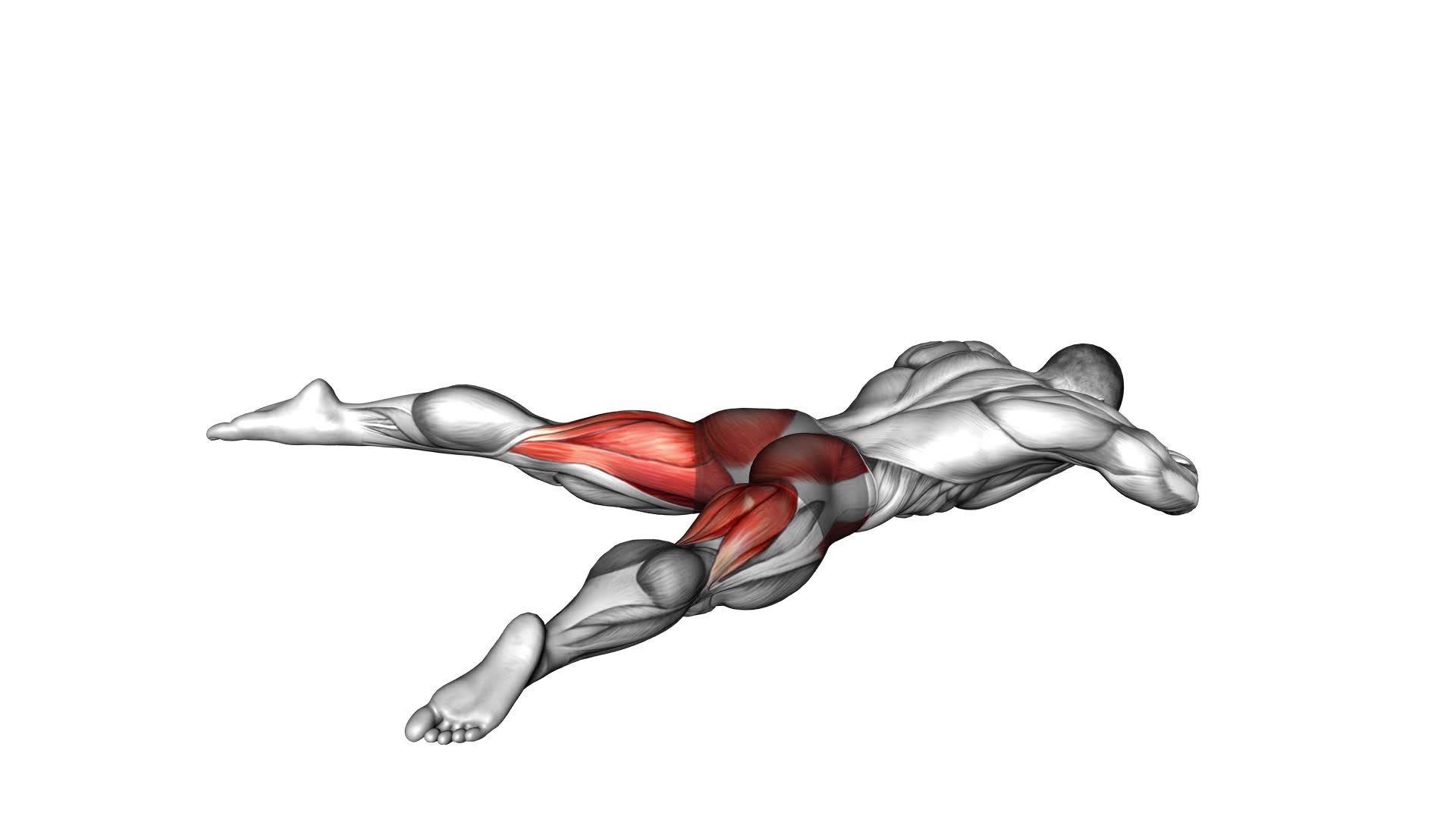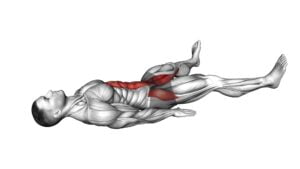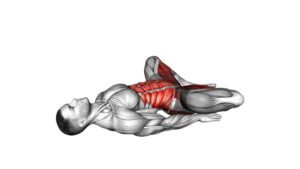Lying Leg Abduction (male) – Video Exercise Guide & Tips

Are you looking to strengthen your lower body and improve your hip mobility? Look no further than lying leg abduction exercises!
Watch This Exercise Video
In this video exercise guide, we'll show you the proper technique for performing this exercise, common mistakes to avoid, and tips for maximizing its effectiveness.
With variations and progressions included, you'll be able to tailor your workout routine to suit your fitness level.
Get ready to take your leg workouts to the next level!
Key Takeaways
- Lying Leg Abduction strengthens and tones muscles in the hips and glutes.
- It targets specific muscles such as the gluteus medius, gluteus minimus, and tensor fasciae latae.
- Lying Leg Abduction improves hip stability, balance, and flexibility.
- It helps prevent injuries related to hip and pelvic instability.
Benefits of Lying Leg Abduction for Males
Improve your lower body strength and flexibility by incorporating lying leg abduction into your workout routine. This exercise is particularly beneficial for hip strengthening and glute activation in males.
Lying leg abduction targets the muscles in your hips and glutes, helping to strengthen and tone them. By lying on your side and lifting your top leg away from your body, you engage the gluteus medius and minimus muscles, as well as the tensor fasciae latae muscle. These muscles are responsible for stabilizing your hips and pelvis, which is important for maintaining balance and preventing injuries.
Additionally, lying leg abduction can help to improve your hip flexibility. As you lift your leg, you're stretching the muscles in your hips, including the hip adductors. This can be particularly beneficial for males who tend to have tight hip muscles due to factors such as sitting for long periods or performing repetitive movements.
Incorporating lying leg abduction into your workout routine can have a positive impact on your lower body strength and flexibility. By targeting the muscles in your hips and glutes, you can improve your overall athletic performance and reduce the risk of injuries. So, add this exercise to your routine and start reaping the benefits today.
Proper Technique for Performing Lying Leg Abductions
To ensure that you perform lying leg abductions correctly, it's important to avoid common mistakes that can compromise the effectiveness of the exercise.
Common Mistakes to Avoid
What are some common mistakes you should avoid when performing lying leg abductions?
Proper technique is crucial for maximizing the effectiveness of your hip abduction workout and preventing injury. One common mistake isn't maintaining correct foot alignment. To perform the exercise correctly, ensure that your toes are pointing forward and your feet are parallel to each other. Avoid letting your feet turn outwards or inwards as this can strain your knees and hips.
Another mistake to avoid is using momentum instead of controlled movements. It's important to engage your hip muscles and consciously lift your legs, rather than relying on swinging or jerking motions.
Lastly, be mindful of not arching your lower back during the exercise. Keep your core engaged and maintain a neutral spine position to protect your lower back.
Benefits of Leg Abductions
To maximize the effectiveness of your hip abduction workout and prevent injury, it's important to perform lying leg abductions with proper technique. Lying leg abductions are a great exercise for hip strengthening and glute activation. By performing this exercise correctly, you can target and engage the muscles in your hips and glutes more effectively. This will help improve your stability and overall lower body strength.
To perform lying leg abductions properly, lie flat on your back with your legs extended. Slowly raise one leg out to the side, keeping it straight and maintaining control. Pause at the top of the movement and then slowly lower your leg back down. Repeat on the other side.
Common Mistakes to Avoid During Lying Leg Abductions
To perform lying leg abductions correctly, it's important to pay attention to your hip alignment. Keep your hips stacked one on top of the other to avoid any twisting or tilting.
Additionally, be mindful of your foot positioning. Ensure that your feet are parallel and facing forward, as turning them in or out can lead to improper muscle activation and potential injury.
Hip Alignment Tips
Align your hips properly to avoid common mistakes during lying leg abductions.
Proper hip alignment is crucial for maximizing the effectiveness of this exercise and preventing injury. Before starting the exercise, it's important to perform hip mobility exercises to ensure your hips are flexible and mobile. This will allow for a full range of motion during the abductions.
Additionally, strengthening the hip muscles through exercises such as squats and lunges can help improve hip alignment.
During the lying leg abduction, make sure to keep your hips stacked directly on top of each other. Avoid allowing your top hip to roll forward or backward, as this can put unnecessary strain on the lower back and lead to poor form.
By maintaining proper hip alignment, you can target the desired muscles effectively and reduce the risk of injury.
Now, let's move on to discussing foot positioning mistakes.
Foot Positioning Mistakes?
Avoid positioning your feet too close together or too far apart during lying leg abductions. Proper foot positioning is crucial for maximizing the effectiveness of the exercise and preventing injuries. Here are some common foot positioning mistakes to avoid:
- Placing your feet too close together can limit the range of motion and decrease the activation of the target muscles. It may also cause strain on your lower back.
- On the other hand, placing your feet too far apart can put excessive stress on your hip joints and result in discomfort or even injury.
- Aim for a hip-width distance between your feet to ensure stability and proper alignment throughout the movement.
By avoiding these foot positioning mistakes, you can perform lying leg abductions with optimal form and reduce the risk of injury.
Now, let's move on to the next section, where we'll discuss tips for maximizing the effectiveness of lying leg abductions.
Tips for Maximizing the Effectiveness of Lying Leg Abductions
To maximize the effectiveness of your lying leg abductions, consistently perform this exercise as part of your regular workout routine. This will ensure that you're maximizing results and activating the targeted muscles effectively.
Firstly, it's important to focus on your form during this exercise. Lie flat on your back with your legs extended and your feet together. Keep your core engaged throughout the movement to maintain stability and prevent any unnecessary strain on your lower back.
When performing the leg abduction, make sure to control the movement and avoid any jerking or swinging motions. Slowly lift your legs out to the sides, keeping them straight, until you feel a stretch in your outer thighs. Pause for a second at the top of the movement and then slowly lower your legs back down to the starting position.
To further enhance the effectiveness of this exercise, you can incorporate resistance bands or ankle weights. These additional tools will add resistance, challenging your muscles even more and promoting muscle growth and strength.
Remember to breathe properly throughout the exercise, inhaling as you lower your legs and exhaling as you lift them. And always listen to your body – if you feel any pain or discomfort, adjust your range of motion or seek guidance from a fitness professional.
Variations and Progressions of the Lying Leg Abduction Exercise
Try incorporating different variations and progressions of the lying leg abduction exercise to challenge your leg muscles even further. Here are three variations and progressions that you can try:
- Weighted Leg Abduction: Hold a dumbbell or a weighted plate on the top of your thigh while performing the leg abduction exercise. This added resistance will increase the intensity and further engage your leg muscles.
- Resistance Band Leg Abduction: Attach a resistance band around your thighs, just above your knees. As you perform the leg abduction exercise, the resistance band will provide constant tension, making your muscles work harder.
- Single Leg Abduction: Instead of lifting both legs together, try lifting one leg at a time. This variation adds an element of instability, forcing your muscles to work harder to maintain balance and control.
By incorporating these variations and progressions, you can target your leg muscles in different ways, ensuring that you continue to challenge and improve their strength and endurance.
Remember to start with lighter weights or resistance bands and gradually increase the intensity as your muscles adapt and get stronger. Always listen to your body and stop if you experience any pain or discomfort.
Sample Workout Routine Incorporating Lying Leg Abductions
To maximize the benefits of lying leg abductions, incorporate them into your sample workout routine. This exercise targets your hip abductors, which are important for stabilizing the pelvis and improving overall lower body strength. Here's a sample workout routine that includes lying leg abductions:
- Warm-up: Start with 5-10 minutes of light cardio, such as jogging or cycling, to get your muscles warmed up and ready for exercise.
- Compound exercises: Begin your workout with compound exercises like squats or lunges to engage multiple muscle groups and increase overall strength.
- Lying leg abductions: Perform 3 sets of 12-15 repetitions of lying leg abductions. You can modify the workout by using resistance bands around your thighs or by adding ankle weights for added intensity.
- Leg press: Move on to the leg press machine for 3 sets of 10-12 repetitions. Adjust the weight according to your fitness level and gradually increase the resistance over time.
- Single-leg deadlifts: Incorporate single-leg deadlifts into your routine to further target your hip abductors and improve balance. Aim for 2-3 sets of 8-10 repetitions on each leg.
- Cool-down: End your workout with a 5-10 minute cool-down, which can include stretching exercises to improve flexibility.
Remember to listen to your body and adjust the workout modifications and equipment options according to your fitness level and goals.
Frequently Asked Questions
Can Lying Leg Abductions Help Improve Flexibility in the Hips and Groin?
Lying leg abductions are a great exercise for improving hip flexibility and stretching the groin muscles. By performing this exercise, you can target these areas and gradually increase their range of motion. The movement involved in leg abductions helps to lengthen and strengthen the hip muscles, which ultimately leads to improved flexibility.
Additionally, stretching the groin muscles can help alleviate tightness and discomfort in that area. Incorporating lying leg abductions into your workout routine can be beneficial for enhancing overall flexibility and muscle health.
Is It Necessary to Use Resistance Bands or Weights While Performing Lying Leg Abductions?
Using resistance bands or weights while performing lying leg abductions can be beneficial for your leg workouts. Resistance bands can provide added resistance and help to strengthen your leg muscles.
Additionally, using weights can increase the intensity of the exercise and help to build muscle mass. Incorporating resistance bands for other leg exercises and using weights can provide variety to your workout routine and help you achieve better overall strength and flexibility in your legs and hips.
How Many Sets and Repetitions Should Be Done During a Lying Leg Abduction Workout?
When performing a lying leg abduction workout, it's important to focus on proper form and technique.
Start by lying on your side with your legs straight.
Slowly lift your top leg as high as you can without rotating your hips or bending your knee.
Hold for a second and then lower back down.
Aim for 3 sets of 12-15 repetitions on each side.
Be careful not to rush through the exercise or use momentum to lift your leg.
Are There Any Modifications or Alternatives for Individuals With Lower Back Pain or Injuries?
If you're dealing with lower back pain or injuries, there are modifications and alternative exercises you can try. When it comes to modifications, you can opt for a smaller range of motion or use resistance bands to reduce strain on your lower back.
Alternatively, you can try exercises like glute bridges, clamshells, or side-lying leg lifts, which target similar muscles without putting as much stress on the lower back.
Remember to always consult with a medical professional before starting any new exercise routine.
Can Lying Leg Abductions Be Beneficial for Athletes or Individuals Involved in Sports That Require Lateral Movements?
Lying leg abductions can be highly beneficial for athletes or individuals involved in sports that require lateral movements. This exercise targets the muscles of the outer thighs, hips, and glutes, which are crucial for stability and power during side-to-side movements. It helps improve agility, balance, and overall lower body strength.
Additionally, there are variations of lying leg abductions available for different fitness levels, ensuring that everyone can reap the benefits of this exercise.
Conclusion
In conclusion, lying leg abductions are a beneficial exercise for males looking to strengthen their hip muscles and improve overall lower body stability. By following proper technique and avoiding common mistakes, individuals can maximize the effectiveness of this exercise.
Incorporating variations and progressions into a workout routine can further challenge the muscles and promote growth. Remember to consult with a fitness professional before starting any new exercise program to ensure proper form and prevent injury.

Author
Years ago, the spark of my life’s passion ignited in my mind the moment I stepped into the local gym for the first time. The inaugural bead of perspiration, the initial endeavor, the very first surge of endorphins, and a sense of pride that washed over me post-workout marked the beginning of my deep-seated interest in strength sports, fitness, and sports nutrition. This very curiosity blossomed rapidly into a profound fascination, propelling me to earn a Master’s degree in Physical Education from the Academy of Physical Education in Krakow, followed by a Sports Manager diploma from the Jagiellonian University. My journey of growth led me to gain more specialized qualifications, such as being a certified personal trainer with a focus on sports dietetics, a lifeguard, and an instructor for wellness and corrective gymnastics. Theoretical knowledge paired seamlessly with practical experience, reinforcing my belief that the transformation of individuals under my guidance was also a reflection of my personal growth. This belief holds true even today. Each day, I strive to push the boundaries and explore new realms. These realms gently elevate me to greater heights. The unique combination of passion for my field and the continuous quest for growth fuels my drive to break new ground.



